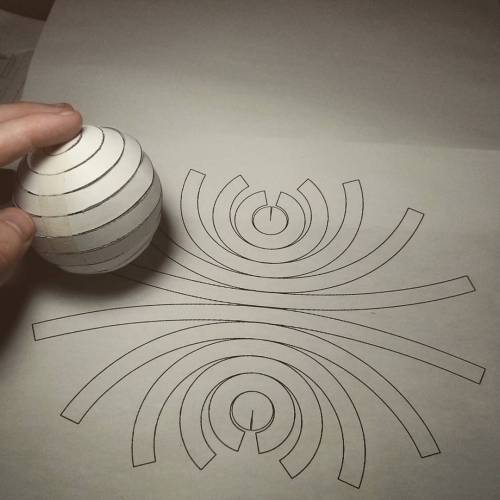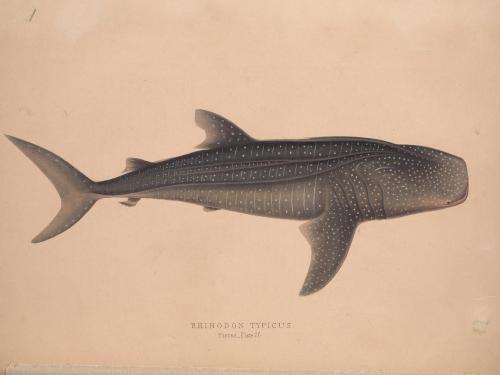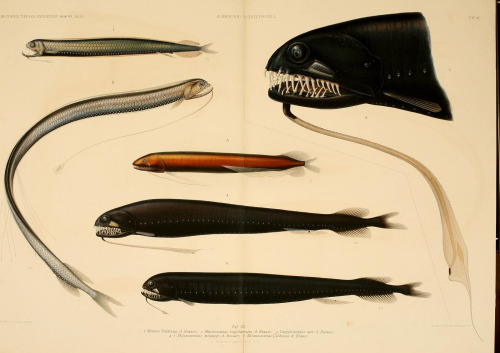Hannahhaifisch - HH
More Posts from Hannahhaifisch and Others


Manganese Dendrites on Limestone
Locality: Solnhofen, Bavaria, Germany


Can you flatten a sphere?
The answer is NO, you can not. This is why all map projections are innacurate and distorted, requiring some form of compromise between how accurate the angles, distances and areas in a globe are represented.
This is all due to Gauss’s Theorema Egregium, which dictates that you can only bend surfaces without distortion/stretching if you don’t change their Gaussian curvature.
The Gaussian curvature is an intrinsic and important property of a surface. Planes, cylinders and cones all have zero Gaussian curvature, and this is why you can make a tube or a party hat out of a flat piece of paper. A sphere has a positive Gaussian curvature, and a saddle shape has a negative one, so you cannot make those starting out with something flat.
If you like pizza then you are probably intimately familiar with this theorem. That universal trick of bending a pizza slice so it stiffens up is a direct result of the theorem, as the bend forces the other direction to stay flat as to maintain zero Gaussian curvature on the slice. Here’s a Numberphile video explaining it in more detail.
However, there are several ways to approximate a sphere as a collection of shapes you can flatten. For instance, you can project the surface of the sphere onto an icosahedron, a solid with 20 equal triangular faces, giving you what it is called the Dymaxion projection.
The Dymaxion map projection.
The problem with this technique is that you still have a sphere approximated by flat shapes, and not curved ones.
One of the earliest proofs of the surface area of the sphere (4πr2) came from the great Greek mathematician Archimedes. He realized that he could approximate the surface of the sphere arbitrarily close by stacks of truncated cones. The animation below shows this construction.
The great thing about cones is that not only they are curved surfaces, they also have zero curvature! This means we can flatten each of those conical strips onto a flat sheet of paper, which will then be a good approximation of a sphere.
So what does this flattened sphere approximated by conical strips look like? Check the image below.
But this is not the only way to distribute the strips. We could also align them by a corner, like this:
All of this is not exactly new, of course, but I never saw anyone assembling one of these. I wanted to try it out with paper, and that photo above is the result.
It’s really hard to put together and it doesn’t hold itself up too well, but it’s a nice little reminder that math works after all!
Here’s the PDF to print it out, if you want to try it yourself. Send me a picture if you do!

69.6027062, -25.5389832

Latest SDO PFSS image for: AIA 0171

Where you will find me today { @ NASA } contemplating formations like ‘cloud streets’ like this activity over the Bering Sea | 📷via @explorenasa + NASA/Goddard | research for #spacelandings2017 #atmosphericresearch #newterrain #environment #sciencematters { cylinders of #spinning #air }






June 8th is World Oceans Day - a day to celebrate the oceans that connect and sustain all of us. Our colleagues at the Biodiversity Heritage Library have been leading up to today with a series of blog posts exploring historic publications that mark important milestones in the progress of marine bioscience research and ocean exploration.
Top image: Whale shark from Illustrations of the zoology of South Africa… v.4 (1845) Middle top : radiolarians and jellyfish from Ernst Haeckle’s Kunstformen der Natur (1904) Middle bottom: giant squid from Cassell’s Natural History v.5-6 and cuttlefish from Voyage de la corvette l'Astrolabe Mollusques and Zoophytes Atlas (1833) Bottom: deep sea fish from Valdivia Expedition…1898-1899. Bd. 15, T. 1



Water is one of those strange materials that expands when it freezes, which raises an interesting question: what happens to a water drop that freezes from the inside out? A freezing water droplet quickly forms an ice shell (top image) that expands inward, squeezing the water inside. As the pressure rises, the droplet develops a spicule – a lance-like projection that helps relieve some of the pressure.
Eventually the spicule stops growing and pressure rises inside the freezing drop. Cracks split the shell, and, as they pull open, the cracks cause a sudden drop in pressure for the water inside (middle image). If the droplet is large enough, the pressure drop is enough for cavitation bubbles to form. You can see them in the middle image just as the cracks appear.
After an extended cycle of cracking and healing, the elastic energy released from a crack can finally overcome surface energy’s ability to hold the drop together and it will explode spectacularly (bottom image). This only happens for drops larger than a millimeter, though. Smaller drops – like those found in clouds – won’t explode thanks to the added effects of surface tension. (Image credit: S. Wildeman et al., source)
Magnetic Field Viewer

BLACK HOLES WITH RAVENOUS APPETITES DEFINE TYPE I ACTIVE GALAXIES
** Synopsis: New research suggests that the central black holes in Type I and Type II active galaxies consume matter at different rates, upending popular theory. **
For decades, astronomers have tried to pin down why two of the most common types of active galaxies, known as Type I and Type II galaxies, appear different when observed from Earth. Although both galaxy types host voracious supermassive black holes known as active galactic nuclei, which actively swallow matter and emit massive amounts of radiation, Type I galaxies appear brighter to astronomers’ telescopes.
New research from an international team of astronomers, with contributions from the University of Maryland, makes a major modification to a popular theory called the unified model. According to this model, the active nuclei of Type I and Type II galaxies have the same fundamental structure and energetic profile, but appear different solely because the galaxies point toward Earth at different angles. Specifically, Type II galaxies are tilted such that they are obscured by their own rings of dust, making Type I galaxies appear brighter by comparison.
The new results, published September 28, 2017, in the journal Nature, suggest that Type I and Type II galaxies do not just appear different – they are, in fact, very different from each other, both structurally and energetically. The key factor that distinguishes Type I and Type II galaxies is the rate at which their central black holes consume matter and spit out energy, according to the researchers.
“The unified model has been the prevailing wisdom for years. However, this idea does not fully explain the differences we observe in galaxies’ spectral fingerprints, and many have searched for an additional parameter that fills in the gaps,” said Richard Mushotzky, a professor of astronomy at UMD and a co-author of the study. “Our new analysis of X-ray data from NASA’s Swift Burst Alert Telescope suggests that Type I galaxies are much more efficient at emitting energy.”
To conduct the study, Mushotzky and his colleagues re-examined data from 836 active galaxies detected by NASA’s Swift Burst Alert Telescope that strongly emit high-energy, or “hard,” X-rays – the same X-rays that medical technicians use to visualize the human skeleton.
To measure the mass and growth rate of these galaxies’ active nuclei – the supermassive black holes at the galaxies’ centers – the researchers used data from 12 different ground-based telescopes spread across the globe to complement the data from the Swift satellite.
“This project began in 2009, as part of my doctoral work at UMD, and has radically grown with the help of more than 40 researchers across the globe,” said Michael Koss (M.S. ‘07, Ph.D. ‘11, astronomy), a research scientist at Eureka Scientific, Inc. and a co-author of the paper. “When I started out, I spent a month of lonely nights by myself at the Kitt Peak National Observatory observing a few dozen galaxies. I never dreamed we would eventually expand to such a large sample, enabling us to answer many amazing scientific questions for the first time.”
By comparing differences in the X-ray spectra between Type I and Type II galaxies, the researchers concluded that, regardless of which way the galaxy faces Earth, the central black holes in Type I galaxies consume matter and emit energy much faster compared with the black holes at the center of Type II galaxies.
“Our results suggest this has a lot to do with the amount of dust that sits close to the central black hole,” said Mushotzky, who is also a fellow of the Joint Space-Science Institute. “Type II galaxies have a lot more dust close to the black hole, and this dust pushes against the gas as it enters the black hole.”
For decades, astronomers preferentially studied Type II galaxies, largely because the active nuclei of Type I galaxies are very bright, making it difficult to see the stars and gas clouds that constitute the rest of the galaxy. Because the unified model suggested that all active galaxies were fundamentally the same, astronomers focused their efforts on the galaxies that host Type II active nuclei because they are easier to observe.
“But now, because our results suggest that the two types of galaxies are indeed fundamentally different, it is likely that a lot of researchers will re-evaluate their data and take another look at Type I galaxies,” Mushotzky said. “By putting us on a path to better understand the differences between the galaxies that host Type I and Type II active nuclei, this work will help us better understand how supermassive black holes influence the evolution of their host galaxies.”
IMAGE….Many active galactic nuclei are surrounded by large, dark, donut-shaped clouds of gas and dust, as seen in this artist’s rendering. A popular theory known as the “unified theory” suggests that differences in the brightness of active galactic nuclei, as seen from here on Earth, are due to the placement of this donut of obscuring dust relative to our angle of observation. However, new research suggests that two of the most common types of active galactic nuclei do, in fact, exhibit fundamental physical differences in the way they consume matter and spit out energy. Credit: NASA/JPL-Caltech
-
 hannahhaifisch reblogged this · 9 years ago
hannahhaifisch reblogged this · 9 years ago -
 hannahhaifisch liked this · 9 years ago
hannahhaifisch liked this · 9 years ago -
 cgg-berlin reblogged this · 10 years ago
cgg-berlin reblogged this · 10 years ago